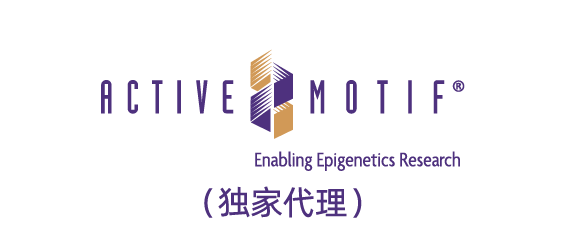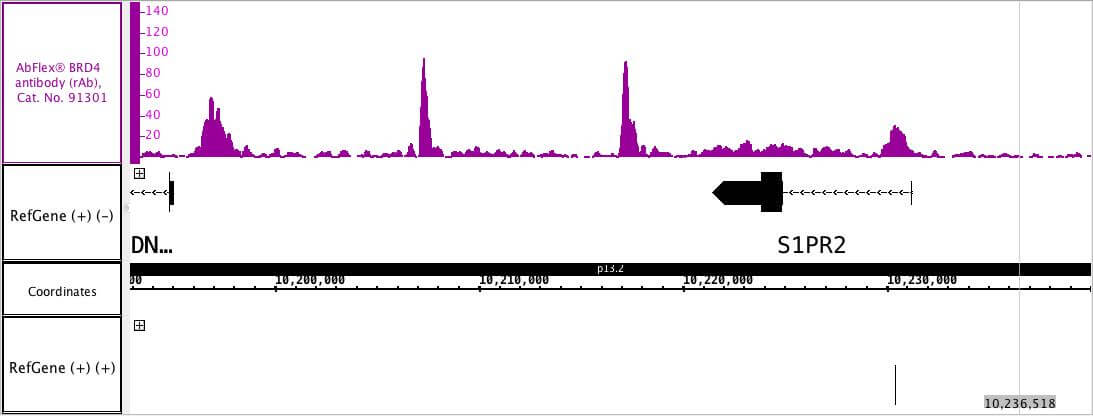AbFlex BRD4 antibody (rAb)
Host / Isotype
Rabbit / IgG
Reactivity
Human
Applications
ChIP, ChIP-Seq
Cat No : 91301,91302 91301
Synonyms
验证数据展示
产品信息
| Tested Applications |
ChIP, ChIP-Seq
Applications Validated by Active Motif: ChIP-Seq: 4 ug per ChIP |
| Tested Reactivity | Human |
| Host / Isotype | Rabbit / IgG |
| Class | Recombinant |
| Type | Antibody |
| Immunogen | This antibody was raised against a recombinant protein comprising amino acids 149-284 of human BRD4. |
| Full Name | AbFlex BRD4 antibody (rAb) |
| Synonyms | BRD4, Bromodomain-containing protein 4, HUNK1, brd 4, brd-4, brd, bromodomain, bromo domain, MCAP, Recombinant Antibody |
| Molecular weight | 180 kDa |
| GenBank accession number | NP_490597 | Purification Method | Protein A Chromatography |
| Buffer | Purified IgG in 140 mM Hepes, pH 7.5, 70 mM NaCl, 32 mM NaOAc, 0.035% sodium azide, 30% glycerol. Sodium azide is highly toxic. |
| Storage | Some products may be shipped at room temperature. This will not affect their stability or performance. Avoid repeated freeze/thaw cycles by aliquoting items into single-use fractions for storage at -20°C for up to 2 years. Keep all reagents on ice when not in storage. |
背景介绍
AbFlex antibodies are recombinant antibodies (rAbs) that have been generated using defined DNA sequences to produce highly specific, reproducible antibodies. Each AbFlex antibody contains a 6xHis Tag, a Biotinylation Tag for enzymatic biotin conjugation using the biotin ligase, BirA, and a sortase recognition motif (LPXTG) to attach a variety of labels directly to the antibody including fluorophores, enzymatic substrates (HRP, AP), peptides, drugs as well as solid supports. AbFlex BRD4 antibody was expressed in 293 cells and contains rabbit immunoglobulin heavy and light chains. BRD4 (Bromodomain-containing protein 4) belongs to the BET subclass of proteins, which are characterized by two N-terminal bromodomains and one ET (Extra Terminal) domain. BRDs associate with chromatin through their bromodomains that recognize acetylated histone lysine residues. bromodomains function as ‘readers’ of these epigenetic histone marks and regulate chromatin structure and gene expression by linking associated proteins to the acetylated nucleosomal targets. The ET domain functions as a protein binding motif and exerts atypical serine-kinase activity. The BET family consists of at least four members in mouse and human, BRD2 (also referred to as FSRG1, RING3), BRD3 (FSRG2, ORFX), BRD4 (FSRG4, MCAP/HUNK1), and BRDT (FSRG3, BRD6). BRD proteins are related to the female Sterile Homeotic protein gene in Drosophila, a gene required maternally for proper expression of other homeotic genes, such as Ubx, which is involved in pattern formation. BRD4 has been identified recently as a therapeutic target in many cancers, including acute myeloid leukemia, multiple myeloma, Burkitt’s lymphoma, NUT midline carcinoma, colon cancer, and breast cancer. BRD4 regulates the transcription of oncogenes, HIV, and human papilloma virus (HPV). It has been shown to bind and phosphorylate RNA pol II, which implicates its involvement in the regulation of eukaryotic transcription. It shows binding specificity for acetylated H3K9, H3K9/ K14, H4K5, H4K8, H4K12, H4K5/K8, H4K5/K12, H4K8/K12, H4K12/K16, H4K12/K16/K20 and H4K5/K8/K12/K16, as well as acetylated RelA-K310.

